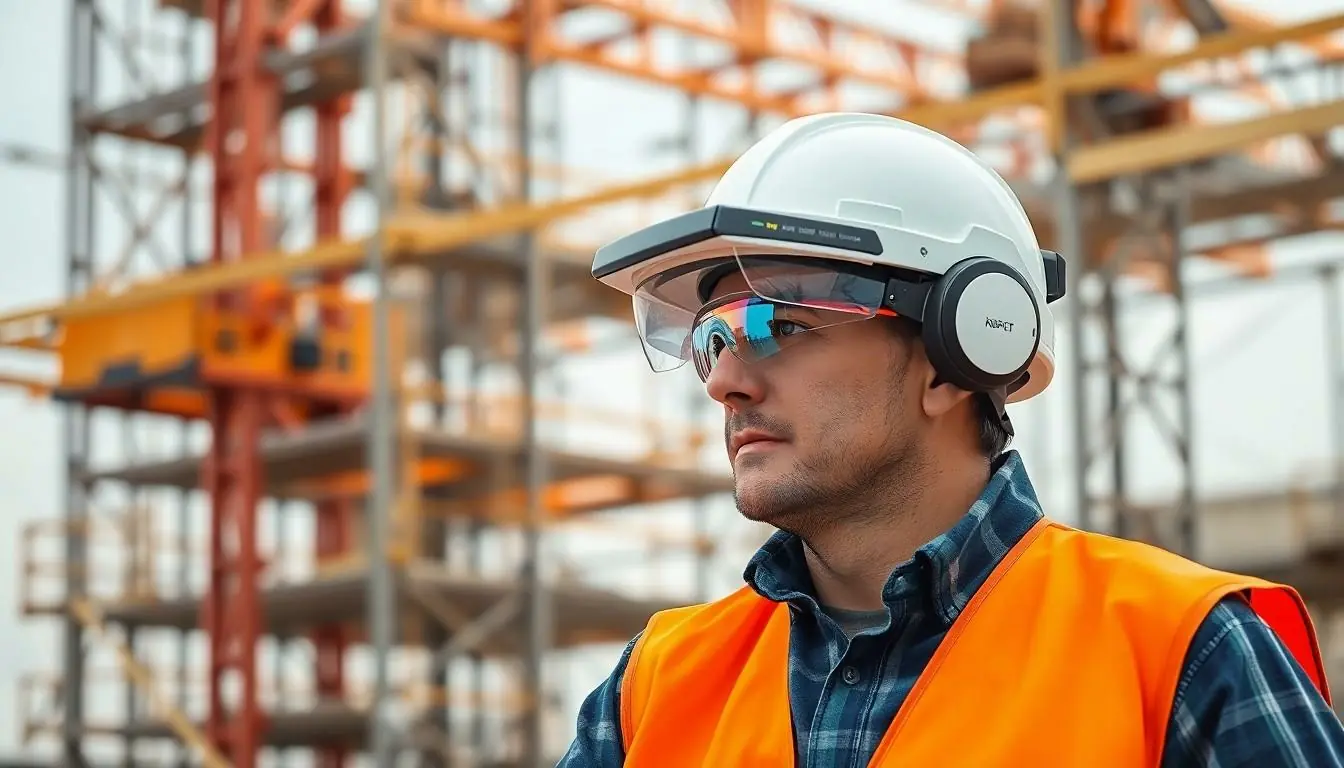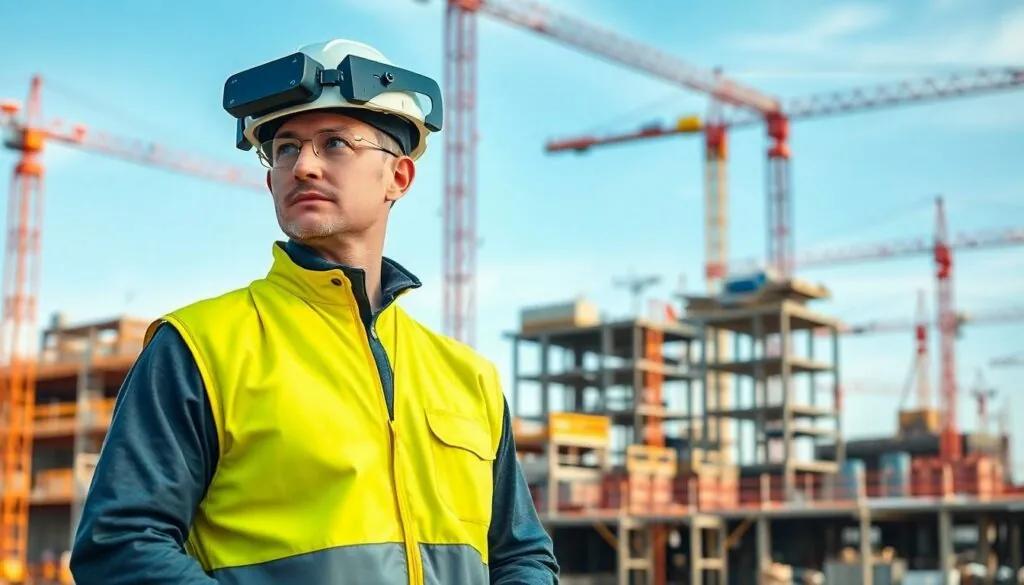Table of Contents
ToggleIn a world where hard hats and steel-toed boots reign supreme, construction wearables are stepping up to the plate like a superhero with a tool belt. Imagine a future where your helmet not only protects your noggin but also tells you when it’s time to take a break or alerts you to potential hazards. These innovative gadgets are transforming job sites into smart environments, making workers safer and more productive—all while looking like they just walked off a sci-fi movie set.
Gone are the days of relying on gut feelings and outdated safety protocols. With construction wearables, workers can harness cutting-edge technology to enhance their efficiency and well-being. From smart helmets to exoskeletons, these devices are not just cool; they’re essential. So, buckle up and get ready to explore how construction wearables are revolutionizing the industry, one gadget at a time.
Overview of Construction Wearables
Construction wearables have emerged as pivotal assets within the industry. These devices, including smart helmets and exoskeletons, enhance not only safety but also productivity. Smart helmets, for instance, integrate augmented reality and communication tools, allowing workers to receive real-time updates and alerts directly in their line of sight. Exoskeletons provide additional physical support, reducing fatigue during repetitive tasks and enabling workers to lift heavy materials with ease.
Technology plays a significant role in managing health and safety on job sites. Wearable sensors monitor vital signs and track environmental conditions, identifying potential hazards before they escalate. Data collected from these wearables offers invaluable insights into worker performance and overall site safety, driving improvements in operational efficiency.
The shift to tech-driven solutions helps redefine traditional safety protocols. Employers can analyze data trends and adapt strategies promptly, minimizing risks. In environments where every second counts, immediate communication and alerts facilitate quicker responses to emergencies.
Furthermore, industry adoption of construction wearables has grown significantly. According to recent studies, nearly 40% of firms planned to integrate wearables into their operations by 2025. These statistics highlight a clear trend: companies recognize the benefits of investing in smart technology for their workforce.
A future enriched with advanced wearables promises a smarter and safer construction landscape. Workers equipped with these devices boost not only their own safety but also the collective health of job sites. Enhanced awareness through wearables fosters a culture of safety, aligning with the industry’s ongoing commitment to worker protection and efficiency.
Benefits of Construction Wearables

Construction wearables offer significant advantages, primarily in safety and productivity. These devices play an essential role in modernizing the industry.
Enhanced Safety Features
Enhanced safety features emerge as a core benefit of construction wearables. Smart helmets equipped with augmented reality provide real-time information about job sites. Workers gain immediate access to updates and alerts, significantly minimizing risks. Wearable sensors track vital signs and environmental conditions, ensuring prompt identification of potential hazards. Data collected from these devices empowers employers to make informed decisions about safety protocols. A proactive approach to safety emerges from this data analysis, reducing incidents and fostering a culture of protection. With nearly 40% of firms planning to adopt such technology by 2025, commitment to safety in the construction industry continues to grow.
Improved Productivity
Improved productivity is another key advantage of using construction wearables. These devices, such as exoskeletons, assist workers in lifting heavy materials, reducing physical strain. Less fatigue leads to better focus and efficiency on tasks. Instant communication features allow teams to coordinate efforts seamlessly, reducing downtime. Enhanced information access streamlines workflows, enabling workers to perform tasks more effectively. Productivity gains become tangible as teams complete projects faster and more accurately. The integration of wearables signifies a shift toward innovative operational strategies in construction, illustrating a future of increased efficiency.
Types of Construction Wearables
Construction wearables come in various forms, each designed to enhance safety and productivity on job sites. These innovative devices range from smart helmets to wearable exoskeletons, offering unique functionalities.
Smart Helmets
Smart helmets incorporate augmented reality and communication tools, allowing workers to access vital information without obstructing visibility. Features often include real-time alerts about hazards, video feeds for remote assistance, and enhanced visibility through built-in lights. Data shows that these helmets significantly reduce miscommunication and errors on site, promoting a safer working environment.
Wearable Exoskeletons
Wearable exoskeletons support workers by reducing physical strain during heavy lifting tasks. These devices enable safer movement and help maintain proper posture, decreasing the risk of musculoskeletal injuries. With the ability to carry loads more efficiently, exoskeletons enhance performance and focus, boosting overall productivity on construction projects.
Safety Vests and Sensors
Safety vests equipped with sensors monitor vital signs and environmental conditions, alerting workers to potential dangers. These vests can track heart rates and exposure to harmful substances. Integration of such technology transforms traditional safety measures, promoting a proactive approach to worker well-being and accident prevention on construction sites.
Challenges in Adoption
Adopting construction wearables presents several challenges that firms must navigate to fully realize their benefits.
Cost Considerations
Initial investment costs for construction wearables can discourage employers from integrating these technologies. Expenses associated with high-quality devices, platforms, and training programs require significant financial commitment. A recent survey indicated that construction firms that allocate budgets specifically for wearables experience better returns on investment over time. Maintenance costs also contribute to the financial burden; ongoing updates and technical support can strain budgets further. Despite these challenges, many firms prioritize safety investments, recognizing that reducing workplace incidents can mitigate long-term costs significantly.
User Acceptance
User acceptance significantly impacts the successful integration of wearables in construction environments. Workers often exhibit resistance to new technologies, which may stem from concerns about privacy and additional monitoring in their roles. Ensuring collaboration and open communication about wearables helps mitigate fears and fosters acceptance. Employers who involve workers in the decision-making process notice higher levels of buy-in and usage. Training that emphasizes the benefits of wearables—such as improved safety and efficiency—further encourages adoption among teams looking to enhance their performance.
Future Trends in Construction Wearables
Increased integration of artificial intelligence marks a key trend in construction wearables. AI enhances capabilities by analyzing data from wearable sensors, leading to more accurate hazard identification. Predictive analytics emerge, allowing employers to anticipate and mitigate risks before incidents occur.
Collaboration with Internet of Things (IoT) devices strengthens operational efficiency. Wearable technology can connect with smart tools and machines, creating a cohesive environment that shares real-time data. This interconnected approach optimizes workflows and boosts communication across teams.
Sustainability initiatives gain momentum within the construction sector through the adoption of eco-friendly wearables. Developers introduce materials that reduce environmental impact while maintaining functionality. Innovative designs incorporate renewable resources, further aligning construction practices with green standards.
Personalization of wearables also stands out. Customizable features permit adjustments based on individual worker needs, enhancing comfort and effectiveness. Tailored experiences promote better user acceptance, fostering a culture of safety.
Furthermore, regulatory frameworks evolve to keep pace with technological advancements. New guidelines ensure safe deployment of construction wearables, addressing privacy concerns and data security. Clear regulations encourage wider adoption, enhancing accountability and transparency within the industry.
Employers increasingly recognize the value of training programs focused on wearable technologies. Comprehensive training ensures that workers understand how to use devices effectively and reap the benefits. This proactive approach engenders a more skilled workforce ready to leverage the latest innovations.
As nearly 40% of firms plan to integrate wearables by 2025, the industry stands on the brink of transformation. Embracing construction wearables fosters a safer, more efficient work environment, significantly enhancing productivity and worker well-being.
The rise of construction wearables marks a pivotal moment for the industry. These innovative tools not only enhance safety but also drive productivity by integrating advanced technology into daily operations. As companies increasingly recognize the advantages of wearables, a significant shift in workplace culture is underway.
With nearly 40% of firms planning to adopt these technologies by 2025, the future looks promising. The combination of real-time data, improved communication, and personalized features ensures that workers are better equipped to face challenges on the job site. Embracing these advancements will ultimately lead to safer environments and more efficient workflows, setting a new standard for construction practices.



